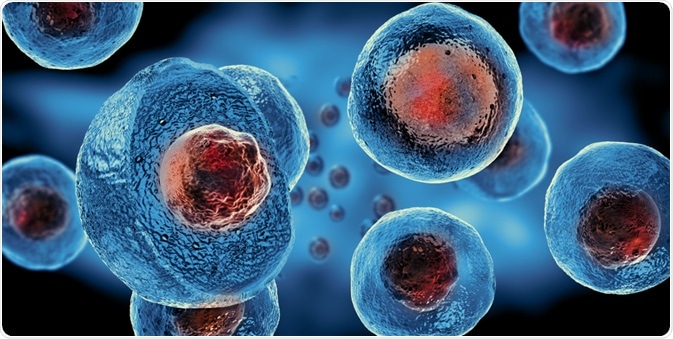Hepatic stem cells are stem cells that are hypothesized to exist in the liver. Stem cells have a capacity for regenerating tissues, which could be crucial in livers affected by loss of hepatocytes due to alcohol or other factors. However, how stem cells function in the liver, their origin, and their use is not well known.
 Image Credit: Giovanni Cancemi/ Shutterstock.com
Image Credit: Giovanni Cancemi/ Shutterstock.com
Hepatocyte loss and the body’s response
Overall, there are three main ways through which it is believed the body responds to the loss of liver cells. One of these is by mature cell proliferation by other hepatocytes, which are thus unipotent and committed to becoming hepatocyte cells.
These types of hepatic cells can respond quickly after liver damage and are also believed to replace old liver cells roughly once a year. However, the proliferation of these cells can be inhibited in some viral diseases.
A second method of liver regeneration is through the use of oval cells, which are located in the canal of Hering. These cells are less specific than hepatocytes, and they can mature into hepatocytes or cells of the bile duct.
These cells are typically activated if the liver injury is chronic or very extensive but can also be activated if the proliferation of hepatocytes is blocked. However, they are less abundant.
The last group are not derived from the liver itself, but rather are believed to originate from hematopoietic stem cells or bone marrow stem cells that are in circulation. As such, they are multipotent with high proliferation potential.
These exogenous stem cells are rare and mainly respond to alcohol injury or hepatocarcinogenesis. However, when they do respond to damage, evidence suggests they can fully restore normal functioning.
What is the evidence for the existence of hepatic stem cells?
It is widely agreed that livers have stem cell potential.
The existence of oval cells as hepatic stem cells is debated. Evidence is strong in rodents, but less so in humans. Human “ductular reactions”, where bile duct-like structures increase in response to liver injury, are considered one of the bigger pieces of evidence for the existence of oval cell hepatic stem cells in humans. Because the markers of oval cells are similar to those of hepatocytes and bile duct cells, their study in humans is difficult.
Studies of stem cell potential in livers have occasionally found that subsequent cell proliferation was not caused by hepatocytes or oval cells, therefore suggesting the existence of a third type of hepatic stem cell.
Since then, evidence of bone marrow stem cells giving rise to muscle and renal cells has been found, and correlations between bone marrow and liver cells have also been discovered.
These correlations have been related to developmental biology, where hematopoietic stem cells were discovered in the fetal liver, proteomics with hematopoietic stem cells, and oval cells showed shared proteins, and transplant studies showed hematopoietic cells localizing to livers after transplantation.
Benefit of hepatic stem cells
Hepatic stem cells have fantastic potential in the treatment of liver disease. Currently, a liver transplant is the most effective treatment for liver failure, but this relies on donors, which are not always available.
Human hepatic stem cells derived from fetal livers have increasingly been seen as a viable alternative, as they can differentiate into necessary liver cells and avoid some of the complications associated with other cell transplants.
Hepatic stem cells have been isolated using flow cytometry, and these cells express several important markers. However, the markers necessary to distinguish hepatic stem cells from fetal liver cells are still being discovered and explored.
There are still significant knowledge gaps in hepatic stem cell research, such as how stem cell activity is activated. Methodologic challenges, such as how to follow liver stem cells to their final differentiation, are being continuously worked on to help confirm where and what type of hepatic stem cells exist.
Sources
- Zhang Y. et al. (2003). Hepatic stem cells: existence and origin. World Journal of Gastroenterology. https://doi.org/10.3748/wjg.v9.i2.201
- Zhang R.R. et al. (2018). Hepatic stem cells with self-renewal and liver repopulation potential are harboured in CDCP1 positive subpopulations of human fetal liver cells. Stem Cell Research and Therapy. https://doi.org/10.1186/s13287-017-0747-3
Further Reading
Last Updated: Nov 14, 2019